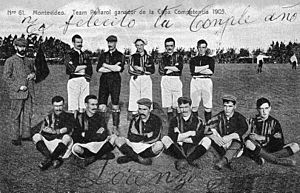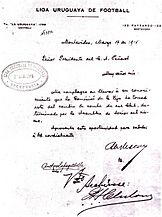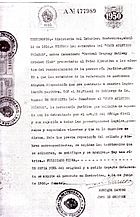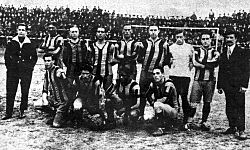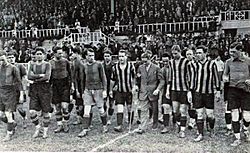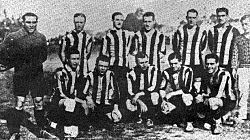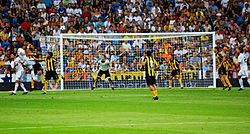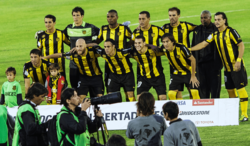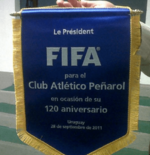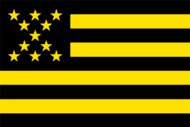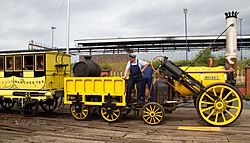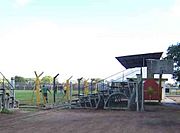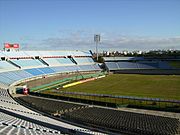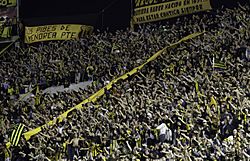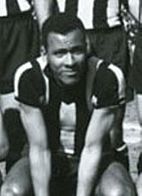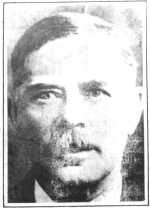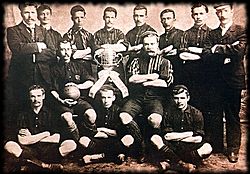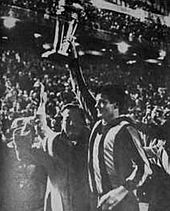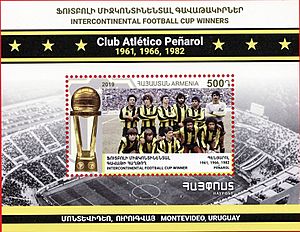Peñarol facts for kids
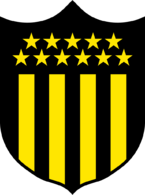 |
||||
| Full name | Club Atlético Peñarol | |||
|---|---|---|---|---|
| Nickname(s) | Decano (The Dean) Manyas Aurinegros (Yellow-and-Blacks) Carboneros (The Coalworkers) Mirasoles (The Sunflowers) |
|||
| Founded | 28 September 1891 (as the Central Uruguay Railway Cricket Club) | |||
| Ground | Estadio Campeón del Siglo | |||
| Capacity | 40,000 | |||
| Chairman | Juan Ignacio Ruglio | |||
| Manager | Diego Aguirre | |||
| League | Primera División | |||
| 2024 | Primera División, 1st of 16 (champions) | |||
|
||||
Club Atlético Peñarol, often called Peñarol, is a famous football club from Montevideo, Uruguay. They play in the Uruguayan Primera División, which is the top football league in Uruguay.
The club's name comes from a neighborhood in Montevideo called Peñarol. This neighborhood was named after a town in Italy called Pinerolo. Peñarol started on September 28, 1891, as the Central Uruguay Railway Cricket Club (CURCC). It was founded by mostly British railway workers who wanted to play cricket. The club changed its name to Peñarol on December 13, 1913. The Uruguayan Football Association has recognized Peñarol as the continuation of CURCC since 1914.
By the 1910s, Peñarol became a strong team in both national and international football. When the FIFA World Cup started in 1930, many Peñarol players were part of the Uruguayan national team. The 1940s began a "golden age" for Peñarol. For the next four decades, the club won many international tournaments with amazing players like Diego Aguirre, Néstor Gonçalves, Fernando Morena, Juan Alberto Schiaffino, Ladislao Mazurkiewicz, and Alberto Spencer. In the 1990s, Peñarol won fewer titles, but they have been very successful in international competitions again since the 2010s.
Peñarol's colors are yellow and black. These colors were inspired by the Stephenson's Rocket, an old train, and the railway workers' uniforms. While football is their main sport, Peñarol has also played athletics, basketball, cycling, futsal, rugby union, and women's football. Since 2016, the club plays its home matches at the Estadio Campeón del Siglo, which can hold 40,000 fans. Before that, they played at Estadio Centenario since 1933. Peñarol currently has 80,000 members.
Peñarol is known as one of the most successful football clubs in the world. In September 2009, the IFFHS named them the best South American club of the 20th century. They have won the Copa Libertadores five times (in 1960, 1961, 1966, 1982, and 1987). They also share the record for most Intercontinental Cup wins with three titles (in 1961, 1966, and 1982). In Uruguay, Peñarol has won 42 league titles in the professional era, and 51 overall if you count their early wins. The club has never been relegated from the top league. They have a big rivalry with Club Nacional de Football, known as El Clásico Uruguayo. This derby is one of the oldest in football, with their first game on July 15, 1900. Peñarol won that match 2–0. As of 2024, Peñarol has won more of these derby matches.
Contents
Club History
How Peñarol Started
On September 28, 1891, workers from the Central Uruguay Railway Company in Montevideo created the Central Uruguay Railway Cricket Club (CURCC). Their goal was to encourage playing cricket, rugby football, and other sports.
The Central Uruguay Railway company had been working in Uruguay since 1878. The club was known as CURCC in the Peñarol neighborhood, which is about 10 kilometers from Montevideo. The club's first president was Frank Henderson, who led the club until 1899.
In 1892, CURCC started focusing more on football. Their first football game was against a team of students from an English high school, and they won 2–0. In 1895, Julio Negrón became the team's first non-British captain.
Winning Early Titles
In 1900, CURCC was one of the first four teams to join the Uruguay Association Football League. They played their first official game on June 10 against Albion and won 2–1. The club won its first Uruguayan championship that year. They also won in 1901, 1905, and 1907. In 1906, Charles W. Bayne took over the railway company and stopped supporting the football team due to money and work issues. This led to the club and company separating in 1913.
In 1908, the club left the Uruguayan league because the league would not let them replay a game. CURCC believed they lost due to bad refereeing. Nacional also left the league in support, agreeing that "matches are won on the pitch." When they returned to competition the next year, relations between the railway company and the club got worse after fans burned a train car.
After winning the 1911 Uruguayan championship, the club tried to make changes, like allowing more non-CUR players and changing the name to "CURCC Peñarol." In June 1913, these ideas were rejected. The railway company decided to separate the football team from the company on December 13, 1913. This is when Peñarol was officially founded. The next day, the first "Clásico" match between Nacional and Peñarol was played.
CURCC continued to play football as an amateur team until it was officially closed on January 22, 1915. All their trophies were given to the British Hospital of Montevideo, not to Peñarol.
Peñarol's Early Years
On March 12, 1914, Peñarol took CURCC's place in the Uruguayan Football League. This request was approved the next day. Peñarol did not win much in its first few years, but a new stadium, Las Acacias, opened on May 19, 1916. The club won its first two league titles in 1918 and 1920.
In November 1922, the Asociación Uruguaya de Fútbol (AUF) removed Peñarol from the league. This happened because Peñarol played a friendly game with Racing, an Argentine club that was part of a rival football association. Peñarol and other clubs then formed a new league, the Uruguayan Football Federation (FUF). Peñarol won the 1924 championship in this new league. The FUF did not last long. Peñarol won the 1926 Copa del Consejo Provisorio, which led to the AUF and FUF joining together.
First Trip to Europe
In 1927, Peñarol went on its first tour to Europe. They played 19 matches against teams from Germany, Switzerland, Austria, Spain, Czechoslovakia, and France. The tour lasted from April to June. Peñarol's first win on the tour was against Eintracht Frankfurt, where they won 3–1.
On June 5, Peñarol played its first game in Spain against FC Barcelona, losing 1–5. The second game against Barcelona ended in a 1–1 tie. Other important games on the tour were two matches against Atlético Madrid, which Peñarol won 5–2 and 4–3.
Peñarol played 19 matches in 80 days. They won 7 games, tied 4, and lost 8. They scored 32 goals and let in 33. Antonio Sacco was their top scorer with 9 goals.
After their European tour in 1927, Peñarol won the Uruguayan championship in 1928 and 1929. The next year, they played their first game at the Centenario Stadium in Montevideo, beating Olimpia 1–0.
Becoming a Strong Team
In 1932, Peñarol and River Plate played the first game of the professional football era in Uruguay. Peñarol won the first Uruguayan professional championship. After finishing second in 1933 and 1934, the club won four league tournaments in a row from 1935 to 1938. They also won the 1936 Torneo Competencia.
The club stayed in second place until 1944, when Peñarol won the Uruguayan Championship again. In 1945, they won the title again. Peñarol also won in 1949.
After finishing second in 1950, Peñarol won the Uruguayan Championship the next year. During the 1950s, the club also won national championships in 1953, 1954, 1958, and 1959.
Winning International Titles
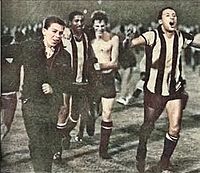
Their 1959 championship allowed Peñarol to play in the new Copa Libertadores. Peñarol won the first two tournaments, beating Olimpia of Paraguay in 1960 and Palmeiras of Brazil in 1961. That year, the club also won its first Intercontinental Cup. Peñarol won three more league titles (1960, 1961, and 1962), making it five championships in a row.
After a quiet year in 1963, Peñarol won the Uruguayan Championship in 1964 and 1965. They won the Copa Libertadores again in 1966, beating River Plate 4–2. That year, the club won its second Intercontinental Cup, defeating Real Madrid 2–0. In the next few years, the club won national championships in 1967 and 1968. Peñarol also had the longest undefeated streak in Uruguayan league history: 56 games, from September 3, 1966, to September 14, 1968. Alberto Spencer, the all-time top scorer in Copa Libertadores, played for Peñarol during this time.
In 1970, the club reached the Libertadores final again, but lost. The club set a tournament record for the biggest goal difference, beating Valencia of Venezuela 11–2. With Fernando Morena as the team's star, the club won the Uruguayan championship for three years in a row, from 1973 to 1975. After finishing second in 1976 and 1977, Peñarol won again in 1978. That year, Morena set two records: most goals scored in a Uruguayan season (36) and most goals scored in a single game (seven). The 1970s ended with another championship in 1979. Morena was the top scorer in the Uruguayan tournament six times in a row.
In the early 1980s, Peñarol won the Uruguayan Championship with Fernando Morena and Rubén Paz. The next season, the club won the Copa Libertadores again, beating Cobreloa of Chile 1–0. Later that year, the club won the Uruguayan championship and its third Intercontinental Cup, defeating Aston Villa 2–0.
Even with money problems in the 1980s, Peñarol won the national championship in 1985 and 1986. They also won a fifth Copa Libertadores in 1987. The club beat América de Cali 1–0 with a goal by Diego Aguirre in the last seconds of extra time.
Peñarol celebrated its 100th anniversary in 1991. With Pablo Bengoechea and young Antonio Pacheco on the team, Peñarol won the Uruguayan championship five times in a row (1993–97). The club also reached the Copa Conmebol final in 1994 and 1995. They ended the century with a national championship in 1999.
In 2000, Peñarol lost the Uruguayan championship final. Peñarol won the national championship again in 2003. The club did not win another national title until the 2009–10 season, when they won the Clausura tournament with 14 wins in 15 games. In the Clausura final, Peñarol defeated Nacional 2–1. This championship allowed the team to play in the Libertadores 2011, where Peñarol reached the final against Santos.
The club was congratulated on its 120th anniversary in September 2011 by football leaders like Joseph Blatter and Michel Platini.
Club Identity
Team Badge and Flag
Throughout its history, Peñarol has made small changes to its symbols, but it has always kept its original colors. The club's shield and flag were designed by architect Constante Facello. They feature five black stripes, four yellow stripes, and eleven yellow stars on a black background. The stars represent the eleven players on the field.
Team Uniforms
Since it was founded, Peñarol's colors have been yellow and black. These colors were inspired by the Rocket locomotive designed by George Stephenson, which won an award in 1829.
The first jersey was a simple shirt with four square sections that alternated black and yellow. Another version had two vertical halves (black on the right and black-and-yellow stripes on the left), with black shorts and socks. Peñarol's official jersey, with black and yellow stripes, has been used almost continuously since 1911, with only small changes.
Influence on Other Clubs
Peñarol even inspired a Romanian club, FC Brașov, to change its colors in December 1966 from white and blue to yellow and black. This happened after Romania's Olympic football team played in Uruguay. A player from FC Brașov, Csaba Györffy, received a shirt from Peñarol's captain Alberto Spencer. Györffy loved the yellow and black stripes. When he returned home, the coach, Silviu Ploeşteanu, decided that the team would look better in the new colors. Since January 1967, FC Brașov has used yellow and black as its official colors, remembering Peñarol.
Uniform History
|
|
|
Kit Manufacturers
| Time Period | Company |
|---|---|
| 1979–84 | |
| 1984–87 | |
| 1987–88 | |
| 1988–91 | |
| 1991–96 | |
| 1996–97 | |
| 1998–2000 | |
| 2000 | |
| 2000–06 | |
| 2006–present |
Club Facilities
Home Stadiums
Peñarol's first stadium was the José Pedro Damiani, also known as Las Acacias. It was bought in 1913 and opened on April 19, 1916. The stadium's entrance was from the former Estadio Pocitos, where the first goal in FIFA World Cup history was scored in 1930.
The José Pedro Damiani stadium is in the Marconi neighborhood of Montevideo. It has a capacity of 12,000. For many years, Peñarol could not play their main matches there due to safety rules. So, the club used the city-owned Estadio Centenario as its home ground. The Centenario stadium opened on July 18, 1930, and can hold 65,235 people.
Las Acacias is now used as the home ground for all of Peñarol's youth teams.
On September 28, 2012, the club announced plans for a new stadium with a capacity of 40,000. This stadium, named Campeón del Siglo (CDS), opened in March 2016 and has been the main home ground ever since.
Club Headquarters
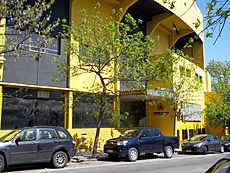
The Palacio Peñarol, located in downtown Montevideo, is the club's main office and also a basketball stadium. It opened on June 21, 1955. Besides basketball, it houses the club's museum and offices. After another stadium collapsed in 2010, the Palacio Peñarol became a very important place for Uruguayan basketball.
Training Grounds
The Complejo Deportivo Washington Cataldi, also known as Los Aromos, is the main training ground for the first team. It is located in Villa Los Aromos, in the Canelones department. Los Aromos was bought in 1945 and built over two years.
For the club's 118th anniversary, the Centro de Alto Rendimiento was opened on September 28, 2009. This new facility includes five football fields, a weight room, and a gym with artificial turf.
Frank Henderson School
The Frank Henderson School, named after the club's first president, is near the Centro de Alto Rendimiento. It was built to help develop the club's young players and provides housing for those who come from other areas.
Peñarol Supporters
In Uruguayan football, people are usually loyal to either Peñarol or Nacional, which divides the country. Both clubs have many fans. While many surveys have been done, they don't always agree on which team has more supporters. For example, a 1993 survey said Peñarol was the favorite for 41% of fans, while Nacional had 38%. A 2006 survey showed Peñarol with 45% and Nacional with 35%.
Peñarol's fan groups have sometimes caused problems, leading to penalties for the club. For example, these actions cost Peñarol points in the league in 1994, 1997, and 2002.
Fan Club Growth
In 2010, the club worked to increase its fan base. They offered special deals and encouraged local fan clubs (called peñas). This campaign was very successful. By February 2013, the club had over 62,000 members, making it the largest fan club in Uruguay.
Big Rivalries
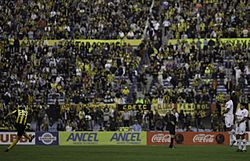
The Uruguayan Derby between Peñarol and Nacional started in 1900. It is one of the oldest football rivalries outside of the British Islands. The first game between Nacional and CURCC (Peñarol's original name) was on July 15, 1900, and CURCC won 2–0. Peñarol has generally had the lead in total wins since the late 1970s. Including amateur and professional games, and friendly matches, the teams have played over 500 times. Peñarol has won more matches than Nacional.
One famous game for Peñarol fans happened on October 9, 1949. It's known as the Clásico de la fuga (the "escape derby"). Peñarol was leading 2–0 at halftime, but Nacional decided not to come back out to play. Peñarol fans believe Nacional did not want to lose to the strong Peñarol team of 1949. Nacional supporters say it was a protest against bad refereeing.
Another memorable game was on April 23, 1987, a friendly match where Peñarol and Nacional were tied 1–1. Three Peñarol players were sent off after a foul and protests. Peñarol had to play with only eight players against Nacional's full team. With eight minutes left, Diego Aguirre scored the winning goal for Peñarol. This win is known as the Clásico de los 8 contra 11 (the "8 against 11 derby").
Peñarol and Nacional have played each other in the final game of the Uruguayan Championship thirteen times, with Peñarol winning eight of them. The most recent was in 2018, when Peñarol won the championship 2–1.
Manyas: The Movie
In October 2011, Manyas: The Movie, a documentary about Peñarol's fans, was released in Uruguay. The film included interviews with fans, journalists, and others. It was very popular, selling 13,000 tickets in its first weekend and 30,000 in its first fifteen days.
World's Biggest Flag
On April 12, 2011, Peñarol fans showed off the largest flag ever displayed in a stadium at that time. The flag was 309 meters long and 46 meters wide, covering a huge area in Centenario Stadium. Later, Nacional displayed an even bigger flag.
Players
Current Team Squad
|
|
Players on Loan
|
Famous Players
Néstor Gonçalves has played the most official games for Peñarol (571 matches) between 1957 and 1970. The team's all-time top scorers in the Primera División are Fernando Morena (203 goals), Alberto Spencer (113 goals), and Óscar Míguez (107 goals). Fernando Morena holds the record for most goals in a single Uruguayan season (36 in 1978). Alberto Spencer is the club's top scorer in international competitions with 58 goals. Spencer and Morena are also the top scorers in Copa Libertadores history for Peñarol.
Peñarol has contributed many players to the Uruguay national football team. For example, five Peñarol players were on the Uruguayan team that won the 1930 FIFA World Cup. Nine Peñarol players were on the Uruguayan team that won the 1950 FIFA World Cup, including Juan Alberto Schiaffino and Alcides Ghiggia, who scored the two goals in the final game against Brazil. Peñarol is the only club that has had players represent Uruguay in all its World Cup appearances.
Club Managers
While it's hard to find exact information about managers from the early amateur days, Peñarol has had 62 coaches during its professional era. The first professional manager was Leonardo de Luca, who coached for two years and won the first professional Uruguayan Championship in 1932.
Most of Peñarol's managers (53) have been Uruguayan. Others have come from Hungary, Britain, Serbia, Brazil, Chile, and Argentina.
Hugo Bagnulo and Gregorio Pérez have coached Peñarol for the longest time, each for eight seasons. Athuel Velásquez had the longest continuous coaching period, five years from 1935 to 1940. Bagnulo has won the most Uruguayan championships (five). In international competitions, Roberto Scarone was the most successful manager, winning two Copa Libertadores and one Intercontinental Cup with Peñarol.
Professional-Era Managers
Caretaker managers are shown in italics.
- Leonardo de Luca (1932–34)
- José Piendibene (1934)
- Athuel Velásquez (1935–40)
- José Piendibene (1940–41)
- Leonardo de Luca (1941)
- Luis Manuel Morquio (1941)
- Lorenzo Fernández (1941–42)
- John Harley (1942)
- Leonardo de Luca (1942–43)
- Juan Pedro Arremón (1943)
- Pedro de Hegedüs (1943)
- Aníbal Tejada (1944)
- Alberto Suppici (1945)
- Aníbal Tejada (1946)
- Jorge Clulow (1947)
- Randolph Galloway (1948)
- Imre Hirschl (1949–51)
- Juan López (1952–55)
- Roque Máspoli and Obdulio Varela (1955–55)
- Imre Hirschl (1956)
- Gerardo Spósito (1957)
- Hugo Bagnulo (1958–59)
- Roberto Scarone (1959–61)
- Béla Guttmann (1962)
- Pelegrín Anselmo (1962)
- Roque Máspoli (1963–67)
- Rafael Milans (1968–69)
- Osvaldo Brandão (1969–70)
- Roque Máspoli (1970–71)
- Juan Eduardo Hohberg (1971)
- Ondino Viera (1972)
- Juan Ricardo Faccio (1972–73)
- Hugo Bagnulo (1973–74)
- José María Rodríguez (1974)
- Hugo Bagnulo (1974–75)
- Juan Alberto Schiaffino (1975–76)
- Roque Máspoli (1976)
- Dino Sani (1977–80)
- Mario Tuane (1980)
- Luis Prais (1980)
- José Etchegoyen (1980)
- Jorge Kistenmacher (1980)
- Alcides Ghiggia (1980)
- Luis Cubilla (1981)
- Hugo Bagnulo (1982–83)
- Osvaldo Balseiro (1983)
- Hugo Fernández (1984)
- César Luis Menotti (1984–85)
- Roque Máspoli (1985–86)
- Ramón Silva (1986)
- Óscar Tabárez (1987)
- Fernando Morena (1988)
- Roque Máspoli (1988)
- Ladislao Mazurkiewicz (1988–89)
- Walter Roque (1989)
- Roberto Fleitas (1989–90)
- César Luis Menotti (1990–91)
- Juan Duarte (1991)
- Ricardo "Tato" Ortiz (1991–92)
- Ljupko Petrović (1992)
- Roque Máspoli (1992)
- Walter Olivera (1992)
- Juan Ricardo Faccio (1992)
- Gregorio Pérez (1993–95)
- Jorge Fossati (1996)
- Alejandro Botello (1996)
- Gregorio Pérez (1997–98)
- Julio Ribas (1999–01)
- Gregorio Pérez (2002)
- Diego Aguirre (2003–05)
- Fernando Morena (2005)
- Luis Garisto (2006)
- Mario Saralegui (24 April 2006 – 30 June 2006)
- Gregorio Pérez (15 July 2006 – 30 June 2007)
- Gustavo Matosas (2007)
- Mario Saralegui (11 March 2008 – 19 January 2009)
- Julio Ribas (20 January 2009 – 14 September 2009)
- Víctor Púa (14 September 2009 – 14 December 2009)
- Diego Aguirre (7 December 2009 – 6 June 2010)
- Manuel Keosseian (1 July 2010 – 23 November 2010)
- Edison Machín (2010)
- Diego Aguirre (7 December 2010 – 6 September 2011)
- Gregorio Pérez (6 September 2011 – 27 February 2012)
- Jorge Gonçalves (27 February 2012 – 1 March 2012)
- Jorge da Silva (1 March 2012 – 30 June 2013)
- Diego Alonso (19 June 2013 – 6 October 2013)
- Jorge Gonçalves (7 October 2013 – 28 January 2014)
- Jorge Fossati (28 January 2014–14)
- Paolo Montero (2014–15)
- Pablo Bengoechea (2015–16)
- Jorge da Silva (2016–October 2016)
- Fernando Curutchet (October 2016-December 2016)
- Leonardo Ramos (December 2016 - June 2018)
- Diego López (June 2018 – December 2019)
- Diego Forlán (January 2020 – September 2020)
- Mario Saralegui (September 2020 – December 2020)
- Mauricio Larriera (December 2020 – August 2023)
Current Coaching Staff
- Coach: Diego Vicente Aguirre
- Assistant coaches: Juan Manuel Olivera
- Trainers: Eduardo Del Capellán
- Goalkeepers' Coach: Óscar Ferro
- Fitness coach: Alejandro Valenzuela
- Assistant fitness coach: Sebastián Roquero
- Head of medical department: Edgardo Rienzi
- Club Doctor: Horacio Deccia
- Nurses: Miguel Domínguez, Fernando Robaina
- Kinesiologists: Marcos Sosa, Mauricio Velázquez
- Equipier: Miguel Santos
- Props man: Germán Pellejero
Club Administration
On September 28, 1891, at a meeting led by Roland Moor, it was decided that the main manager of the Central Uruguay Railway Company would be in charge of the Central Uruguay Railway Cricket Club. The club's first president was Frank Henderson, who served until 1899.
After Henderson, other railway managers were chairmen of the sports club until 1906. Then, Charles W. Bayne took over the railway. Bayne refused to support CURCC because of fan behavior and workers missing work. He was replaced by Roland Moor, another railway employee.
Conflicts continued between the company and the sports club. This led to the football section of CURCC separating from the company and changing its name to Club Atlético Peñarol. Jorge Clulow, an Englishman with Uruguayan nationality, was chosen as the club's chairman from 1914 to 1915.
Club Presidents
- 1891–99: Frank Henderson
- 1899–05: Frank Hudson
- 1906–08: Roland C.J. Moor
- 1909–13: Percy Sedgfield
- 1914–15: Jorge H. Clulow
- 1916–17: Francisco Simón
- 1918: Félix Polleri
- 1919: César Batlle Pacheco
- 1920: Félix Polleri
- 1921–28: Julio María Sosa
- 1929: Arturo Abella
- 1930–31: Luis Giorgi
- 1932: Juan Antonio Scasso
- 1933–34: Alberto Demicheli
- 1934: Pedro Viapina
- 1935–36: Luis Giorgi
- 1937: Francisco Tochetti
- 1938: Alberto Mantrana Garín
- 1939: Eduardo Alliaume
- 1940: Francisco Tochetti
- 1941–42: Bolívar Baliñas
- 1942: Álvaro Macedo
- 1943: Armando Lerma
- 1944–48: Constante Turturiello
- 1949–51: Eduardo Alliaume
- 1952–55: José Buzzetti
- 1956: Raúl Previtali
- 1957: Eduardo Alliaume
- 1958–72: Gastón Guelfi
- 1973–84: Washington Cataldi
- 1985–86: Carlos José Lecueder
- 1987–90: José Pedro Damiani
- 1991–92: Washington Cataldi
- 1993–07: José Pedro Damiani
- 2008–2017: Juan Pedro Damiani
- 2017-2020: Jorge Barrera
- 2020- : Juan Ignacio Ruglio
Honorary
- 1929: Julio María Sosa
- 1938: Francisco Tochetti
- 1949: Constante Turturiello
- 1953: Mantrana Garin
- 1953: Carlos Balsán
- 1961: Gastón Guelfi
- 1978: Washington Cataldi
- 1991: José Pedro Damiani
- Julio María Sanguinetti
Board Members (2020–2023)
| Position | Name |
|---|---|
| President | Juan Ignacion Ruglio |
| Vice President/Treasurer | Eduardo Zaidensztat |
| General secretary | Evaristo González |
| Assistant Secretary | Jorge Nirenberg |
| Assistant Treasurer | Marcos Acle |
| Board Members | Alvaro Queijo |
| Juan Pedro Damiani | |
| Gaston Tealdi | |
| Rodolfo Catino | |
| Pablo Amaro | |
| Guillermo Varela | |
| AUF Delegates | Gonzalo Moratorio |
| Juan Antonio Rodríguez | |
| Julio Trostchansky |
Club Statistics and Records
Peñarol played in the Uruguay Association Football League for 26 seasons, from its start in 1900 until the amateur era ended in 1931. During this time, Peñarol won the Uruguayan Championship nine times. Their best years were in 1900 and 1905, when they won without losing any points. Peñarol was undefeated in 1901, 1903, and 1907.
Since the professional era began in 1932, Peñarol and Nacional are the only teams that have played every season for the Uruguayan championship. Peñarol has won the most Uruguayan League titles (38 times between 1932 and 2013). They also have the most undefeated championships (seven times).
Peñarol's biggest win was 9–0 against Rampla Juniors in 1962. Their worst defeat was 0–6 against Nacional. In international games, their best result was an 11–2 win over Valencia of Venezuela on March 15, 1970. Their worst international loss was 0–6 against Olimpia of Paraguay in 1990.
Peñarol holds many national and international records. The club has the longest undefeated streak in the Uruguayan league: 56 games, from September 3, 1966, to September 14, 1968. This is also the longest undefeated streak in South American professional football.
It was the first club to win the Copa Libertadores de América without losing a single game, in 1960. Peñarol has played in the Copa Libertadores more than any other team (40 times) and has reached the finals the second most times (10). The club holds the record for the biggest win (11–2 against Valencia) and the biggest goal difference in a two-game series (beating Everest from Ecuador 5–0 and 9–1). Peñarol is one of the few teams to have played in five Intercontinental Cup finals.
Club Honours
Senior Team Titles
- Keys
- Record
- (s) Shared record
| Type | Competition | Titles | Winning years |
|---|---|---|---|
| National (League) |
Primera División | 52 | 1900, 1901, 1905, 1907, 1911; 1918, 1921, 1928, 1929, 1932, 1935, 1936, 1937, 1938, 1944, 1945, 1949, 1951, 1953, 1954, 1958, 1959, 1960, 1961, 1962, 1964, 1965, 1967, 1968, 1973, 1974, 1975, 1978, 1979, 1981, 1982, 1985, 1986, 1993, 1994, 1995, 1996, 1997, 1999, 2003, 2009–10, 2012–13, 2015–16, 2017, 2018, 2021, 2024 |
| Primera División (FUF) | 1 |
1924
|
|
| Primera División (Consejo Provisorio) | 1 |
1926
|
|
| Half-year / Short tournament (League) |
Torneo Apertura | 7 |
1995, 1996, 2012–13, 2015–16, 2019, 2023, 2024
|
| Torneo Clausura | 11 |
1994, 1999, 2000, 2003, 2007–08, 2009–10, 2015, 2017, 2018, 2021, 2024
|
|
| Torneo Intermedio | 1 |
2025
|
|
| Torneo Clasificatorio | 2 |
2001, 2002
|
|
| National (Cups) |
Supercopa Uruguaya | 2 |
2018, 2022
|
| Liguilla Pre-Libertadores | 12 |
1974, 1975, 1977, 1978, 1980, 1984, 1985, 1986, 1988, 1994, 1997, 2004
|
|
| Torneo de Honor | 11 |
1944, 1945, 1947, 1949, 1950, 1951, 1952, 1953, 1956, 1964, 1967
|
|
| Torneo Competencia | 11 |
1936, 1941, 1943, 1946, 1947, 1949, 1951, 1953, 1956, 1957, 1986
|
|
| Copa de Honor | 4 |
1907, 1909, 1911, 1918
|
|
| Copa Competencia | 8 |
1901, 1902, 1904, 1905, 1907, 1909, 1910, 1916
|
|
| Torneo Cuadrangular | 5 |
1959, 1960, 1963, 1966, 1968
|
|
| Copa Albion de Caridad | 3 |
1916, 1917, 1921
|
|
| Liga Mayor | 1 |
1978
|
|
| Torneo Artigas - Copa Casa de Catalina | 3 |
1909, 1910, 1911
|
|
| Torneo Especial | 1 |
1929
|
|
| Torneo Campeones Sudamericanos Juveniles | 1 |
1954
|
|
| Campeonato Especial | 1 |
1968
|
|
| Torneo de la República | 1 |
1979
|
|
| Torneo Montevideo | 1 |
1980
|
|
| Torneo Colombes | 1 |
1980
|
|
| Torneo Copa de Oro | 1 |
1982
|
|
| Torneo Prensa Deportiva | 1 |
1983
|
|
| Torneo 60.º Aniversario de Colombes | 1 |
1984
|
|
| International (Cups) |
Intercontinental Cup | 3(s) |
1961, 1966, 1982
|
| Copa Libertadores | 5 |
1960, 1961, 1966, 1982, 1987
|
|
| Intercontinental Champions' Supercup | 1(s) |
1969
|
|
| Copa de Honor Cousenier (AFA/AUF) | 3 |
1909, 1911, 1918
|
|
| Tie Cup (AFA/AUF) | 1 |
1916
|
|
| Copa Aldao (AFA/AUF) | 1 |
1928
|
Under-20 Team Titles
| Type | Competition | Titles | Winning years |
|---|---|---|---|
| International (Cup) |
U-20 Copa Libertadores | 1 | 2022 |
South American Club of the 20th Century
In 2009, the International Federation of Football History & Statistics (IFFHS) named Peñarol the best South American club of the 20th century. The IFFHS gave points for wins in international competitions after 1932. Peñarol was ranked number one, ahead of Independiente from Argentina and their rivals Nacional.
| Rank | Team | Country | Points |
|---|---|---|---|
| 1 | Peñarol | Uruguay | 531 |
| 2 | Independiente | Argentina | 426.5 |
| 3 | Nacional | Uruguay | 414 |
| 4 | River Plate | Argentina | 404.25 |
| 5 | Olimpia | Paraguay | 337 |
| 6 | Boca Juniors | Argentina | 312 |
| 7 | Cruzeiro | Brazil | 295.5 |
| 8 | São Paulo | 242 | |
| 9 | América de Cali | Colombia | 220 |
| 10 | Palmeiras | Brazil | 213 |
Other Sports at Peñarol
Basketball Team
Peñarol's basketball history goes back to the late 1920s. In 1931, a club called Piratas became Peñarol's basketball team. They played their first league game in 1940. By 1943, the team was in the first division and finished third. The next year, Peñarol won the Federal Championship.
In 1945, Peñarol left the Uruguayan Basketball Federation for a new league. When that league failed, they rejoined the federation in 1947. Peñarol won the Federal Championship again in 1952. They also won the Winter Tournament in 1953 and 1955. After a tough period, Peñarol won the Uruguayan Championship in 1973, 1978, and 1979. In 1982, the club had its best season, winning both the Federal Championship and the Winter Tournament. They also won the Campeonato Sudamericano de Clubes in 1983. In 1985, the club was moved down a division, and in 1997, they were removed from the league. However, the club rejoined the Uruguayan Basketball Federation in 2018.
Cycling Team
Peñarol has taken part in the Vuelta Ciclista del Uruguay (Tour of Uruguay) since it started in 1939. In 1952, Dante Sudatti became the first Peñarol cyclist to win the race. Peñarol cyclists also won the overall race in 1953 and 1956. In 1956, the club also won the team championship.
After winning the team championship again in 1959, Peñarol won only one individual championship in 1964. The team improved later, winning three individual titles in a row from 1989 to 1991 and the team victory in 1990 and 1991. In 2002, the club won both the individual and team titles. Peñarol has also competed in other cycling races.
Futsal Team
Peñarol started playing futsal in 1968. In its first two decades, the club won national and international titles, including the 1987 World Interclub Championship. When FIFA took over the sport in 1995, Peñarol began competing in AUF tournaments. The team won the first three Uruguayan Championships (1995, 1996, and 1997). They also won in 1999 and 2004, and then three more times in a row in 2010, 2011, and 2012.
Beach Soccer Team
In January 2013, Peñarol started its beach soccer section. Diego Monserrat, a goalkeeper for the Uruguay national team, became the first coach. Felipe Fernández was the club's first captain. In the same month, Peñarol won a qualification tournament for the "Super Liga," which is the Uruguayan Beach Soccer Championship. After winning their quarter-final and semi-final matches, Peñarol was declared champion.
Rugby Team
Peñarol announced that they would form a rugby union team to play in the first season of the Superliga Americana de Rugby in February 2020. Peñarol Rugby is the only team from Uruguay in this competition.
Peñarol Rugby won the championship of the 2022 Súper Liga Americana de Rugby season.
Esports Division
Peñarol also has an esports division. They have teams that compete in League of Legends and FIFA leagues organized by the Uruguayan Virtual Football Association.
See also
 In Spanish: Club Atlético Peñarol para niños
In Spanish: Club Atlético Peñarol para niños
- Peñarol (basketball)
- Peñarol Rugby
- List of world champion football clubs


